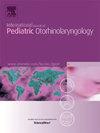Environmental factors and the incidence of pediatric epistaxis: A systematic review with meta-analysis
IF 1.2
4区 医学
Q3 OTORHINOLARYNGOLOGY
International journal of pediatric otorhinolaryngology
Pub Date : 2024-11-01
DOI:10.1016/j.ijporl.2024.112152
引用次数: 0
Abstract
Background
A growing body of literature explores environmental risk factors for pediatric epistaxis, yielding variable results. We aim to clarify these associations through a systematic review and meta-analysis.
Methods
PubMed, Scopus, Cochrane Central Register of Control Trials, Web of Science, Medline, Google Scholars, and Embase were systematically searched up to April 2024. Eligible articles were reviewed, and the quality was assessed. A systematic review and meta-analysis was conducted to clarify correlations between the incidence of epistaxis and multiple environmental factors according to Preferred Reporting Items for Systematic Reviews and Meta-analyses (PRISMA) guidelines.
Results
A total of 8 studies, comprising 55,176 participants, met the inclusion criteria. The incidence of epistaxis peaked during the summer months (Proportion = 12.73 %, CI: 9.629 %–16.201 %). Significant risk factors included environmental variables elevated in the summer, including higher monthly mean temperatures, increased sunlight exposure, elevated O3 levels, and lower atmospheric pressure. In contrast, factors like mean monthly humidity, wind speed, SO2, CO, NO2, and PM-10 levels were not associated with an increased risk of epistaxis.
Conclusions
This meta-analysis underscores the significant impact of multiple environmental factors, particularly those more pronounced during the summer months, on the incidence of pediatric epistaxis.
环境因素与小儿鼻衄的发病率:系统回顾与荟萃分析
背景越来越多的文献探讨了小儿鼻衄的环境风险因素,但结果各不相同。我们旨在通过系统综述和荟萃分析澄清这些关联。方法系统检索了截至 2024 年 4 月的 PubMed、Scopus、Cochrane Central Register of Control Trials、Web of Science、Medline、Google Scholars 和 Embase。对符合条件的文章进行了审查和质量评估。根据《系统综述和荟萃分析首选报告项目》(Preferred Reporting Items for Systematic Reviews and Meta-analyses,PRISMA)指南,进行了系统综述和荟萃分析,以明确鼻衄发病率与多种环境因素之间的相关性。鼻衄的发病率在夏季达到高峰(比例=12.73%,CI:9.629%-16.201%)。重要的风险因素包括夏季升高的环境变量,包括月平均气温升高、日照增加、臭氧浓度升高和气压降低。与此相反,月平均湿度、风速、二氧化硫、一氧化碳、二氧化氮和 PM-10 水平等因素与鼻衄发病风险增加无关。
本文章由计算机程序翻译,如有差异,请以英文原文为准。
求助全文
约1分钟内获得全文
求助全文
来源期刊
CiteScore
3.20
自引率
6.70%
发文量
276
审稿时长
62 days
期刊介绍:
The purpose of the International Journal of Pediatric Otorhinolaryngology is to concentrate and disseminate information concerning prevention, cure and care of otorhinolaryngological disorders in infants and children due to developmental, degenerative, infectious, neoplastic, traumatic, social, psychiatric and economic causes. The Journal provides a medium for clinical and basic contributions in all of the areas of pediatric otorhinolaryngology. This includes medical and surgical otology, bronchoesophagology, laryngology, rhinology, diseases of the head and neck, and disorders of communication, including voice, speech and language disorders.

 求助内容:
求助内容: 应助结果提醒方式:
应助结果提醒方式:


